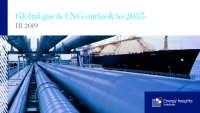McKinsey: Global gas and LNG outlook to 2035 - September 2019 - eng (pdf) Избранное
Expansion in the gas and LNG markets continues, with LNG demand expected to increase 3.6 percent per year to 2035.
Detailed market research and continuous tracking of market developments—as well as deep, on-the-ground expertise across the globe—informs our outlook on global gas and liquefied natural gas (LNG). We forecast gas demand and then use our infrastructure and contract models to forecast supply-and-demand balances, corresponding gas flows, and pricing implications to 2035.
Executive summary
The past year saw the natural-gas market grow at its fastest rate in almost a decade, supported by booming domestic markets in China and the United States and an expanding global gas trade to serve Asian markets. While the pace of growth is set to slow, gas remains the fastest-growing fossil fuel and the only fossil fuel expected to grow beyond 2035.
Global gas: Demand expected to grow 0.9 percent per annum to 2035
While we expect coal demand to peak before 2025 and oil demand to peak around 2033, gas demand will continue to grow until 2035, albeit at a slower rate than seen previously. The power-generation and industrial sectors in Asia and North America and the residential and commercial sectors in Southeast Asia, including China, will drive the expected gas-demand growth. Strong growth from these regions will more than offset the demand declines from the mature gas markets of Europe and Northeast Asia.
Gas supply to meet this demand will come mainly from Africa, China, Russia, and the shale-gas-rich United States. China will double its conventional gas production from 2018 to 2035. Gas production in Europe will decline rapidly.
LNG: Demand expected to grow 3.6 percent per annum to 2035, with market rebalancing expected in 2027–28
We expect LNG demand to outpace overall gas demand as Asian markets rely on more distant supplies, Europe increases its gas-import dependence, and US producers seek overseas markets for their gas (both pipe and LNG). China will be a major driver of LNG-demand growth, as its domestic supply and pipeline flows will be insufficient to meet rising demand. Similarly, Bangladesh, Pakistan, and South Asia will rely on LNG to meet growing demand to replace declining domestic supplies. We also expect Europe to increase LNG imports to help offset declining domestic supply.
Demand growth by the middle of next decade should balance the excess LNG capacity in the current market and planned capacity additions. We expect that further capacity growth of around 250 billion cubic meters will be necessary to meet demand to 2035.
With growing shale-gas production in the United States, the country is in position to join Australia and Qatar as a top global LNG exporter. A number of competing US projects represent the long-run marginal LNG-supply capacity.
Key themes uncovered
Over the course of our analysis, we uncovered five key themes to watch for in the global gas market:
- Global LNG-price indicators have partially converged with the differentials among Asia, Europe, and the United States, falling to the smallest they have been in longer than a decade.
- Asia is leading a third wave of market liberalization after those in the United States and Europe, likely bringing fundamental changes to Asian markets.
- Long-term contract-pricing mechanisms are evolving in indexation and slope as gas and oil markets diverge, placing pressure on buyers to reshape their contract portfolios, with up to $15 billion per year at stake.
- Substantial new investment is necessary to deliver the infrastructure required to meet demand growth.
- Traditional, bilateral business models for LNG are being challenged today, and new business models with an increased focus on commercial and trading capabilities are emerging.
Дополнительная информация
- Серия: Консалтинг и научные центры / McKinsey
- Год: 2019
- Месяц: 9 (III квартал)
- Источник: McKinsey & Company


































